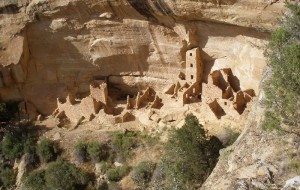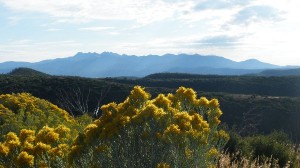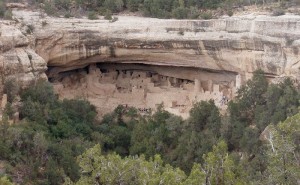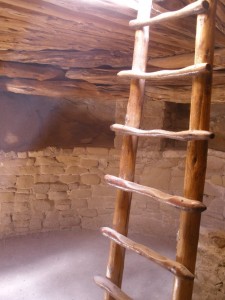
My head is full of the strangest facts – and it’s all my parents’ fault.
When I was a kid, they brought a never-ending stream of books into the house. The types of books were often surprising – I think a lot of the time my parents got them because they were cheap (we didn’t have a lot of money). I read those books from cover to cover – even the encyclopedia!
One which totally captured my imagination at the age of about 10 was a book about the cliff dwellings in the South West of the USA – at Mesa Verde and the surrounding areas.
I was fascinated by the ancient culture that had built such amazing homes – and then just vanished.
Well – I’ve finally been to those cliff dwellings – and all I can say is “Wow!”

We started our exploration with the dwellings on top of the mesa.
According to the national parks service guides, the ancestral Puebloans set up their homes there about 1400 years ago.
The mesa top looks pretty wild now – but the Puebloans had farms there.
They even set up dams to manage the water supply so they could plant corn to go with their wild turkey dinner.
Then – for some reason, they gave up their homes on top of the mesa and started building in rock alcoves on the cliffs.
No-one knows why they moved – but one thing I am sure of – they must have had a pretty good reason.

The parks service has put in ladders and walkways to enable people like me to get to the cliff dwellings.
I’m not afraid of heights, but there were times…
And the original inhabitants didn’t use metal ladders – mostly they had handholds and footholds cut into the sandstone.

Archeologists who studied the grave sites didn’t find evidence of broken bones among the cliff dwellers – so they assume they seldom fell.
They must have been much better rock climbers than we were!
What is even more fascinating is that just a few generations later they suddenly abandoned these homes.
No-one knows why.
Archeologists have speculated about failed crops, warring factions or disease – but they are just guessing.

The ancestral Puebloans left behind paintings and carvings on the wall – but they never had a written language.
There’s nothing to suggest an answer to the mystery.
The descendants of the cliff dwellers still live in the American south-west.
When asked – they say their ancestors left the caves because it was time to go.
Maybe that’s all there was to it – or maybe there is more that is known only to the Pueblo people, who are keeping their secrets.
For my part, I left because it was getting late – and the climb back up was hard enough in daylight.
If the cliff dwellings were spectacular – so too was the landscape.

Webmaster John and I took about a thousand photographs (seriously – we did).
Every time we turned another corner – there was even more breathtaking scenery (the storm clouds helped).
Sometimes reality doesn’t live up to the fantasy… you know what I mean. When we finally achieve a goal, it’s not quite as good as we had hoped. Well, that wasn’t the case for me this time.
The cliff dwellings were every bit as magical and fascinating as I had always dreamed and the landscape even more beautiful.

It’s great when that happens… and this was just the start of the holidays.
The next stop saw us faced with men in uniforms, carrying guns – as we accidentally almost invaded the site of the Manhattan Project – more on that later.
